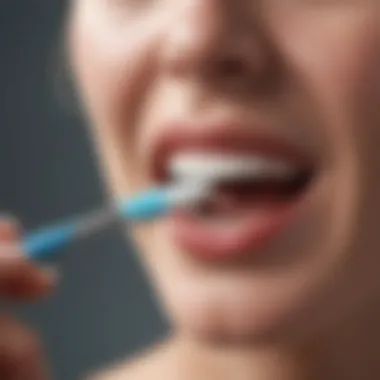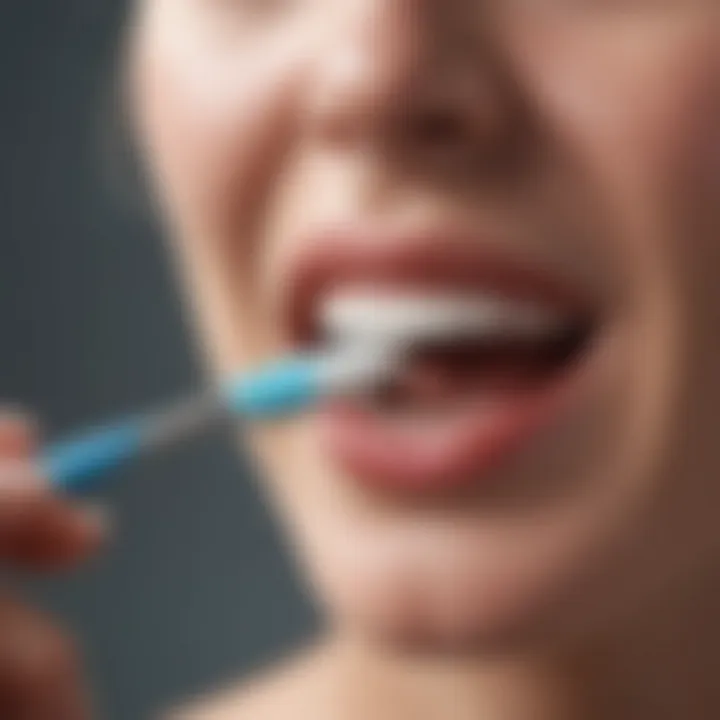Toothpaste's Impact on Managing Gum Disease Effectively


Intro
Gum disease, often sneaky in its onset, can lead to a heap of trouble if left unchecked. To put it plainly, it’s like ignoring a tiny leak in a roof that eventually leads to a major downpour inside your home. Understanding how toothpaste comes into play can transform how one approaches dental health.
Certain toothpaste formulations have emerged as crucial allies in maintaining gum health. Some are packed with specialized ingredients aimed at dismantling harmful bacteria while promoting healing. This article dives into these toothpaste types: why they matter, how they work, and what current research suggests about their effectiveness.
Overview of Research Topic
Brief Background and Context
Toothpaste's journey from basic cleaning paste to a sophisticated therapy for gum disease reflects advancements in dental science. In the past, people relied predominantly on baking soda or salt to scrub their teeth. Fast forward to today, and we've got a plethora of options. Whether it’s fluoride, triclosan, or newer plant-based ingredients, the selection can be overwhelming, yet critical for those battling gum afflictions.
The development of targeted formulas sheds light on the nuances of oral care. Professionals proclaim that preventive care is the cornerstone of good health—and toothpaste is often the first line of defense in this regard. Understanding these innovations forms a crucial part of navigating modern dental hygiene.
Importance in Current Scientific Landscape
The rising prevalence of gum disease is alarming, allegedly affecting nearly half of adults over thirty in the United States. How toothpaste can mitigate such an epidemic is an essential topic within the field of dental research. Effectiveness does not solely hinge on active ingredients, but also on overall dental hygiene practices: from brushing techniques to the regularity with which one visits a dentist.
Furthermore, scientific frameworks are beginning to emphasize the significance of early intervention. As the landscape of research continues to evolve, there's a compelling argument for heightened focus on the toothpaste's role—not just as a cleaning agent but as part of a well-rounded strategy for gum disease management.
"Toothpaste is more than just a tube of minty gel; it's a potential weapon in the fight against gum disease, laden with ingredients scientifically proven to work."
Methodology
Research Design and Approach
This article synthesizes current findings on the efficacy of various toothpaste formulations developed specifically for gum health. To draw accurate conclusions, a systematic approach referencing clinical studies, comparative analyses, and expert opinions has been employed. The intent is to unravel the threads linking toothpaste to overall mouth health while ensuring a nuanced understanding of each active ingredient’s role.
Data Collection Techniques
The research involved a thorough review of existing literature from reputable dental journals, case studies, and popular scientific databases. Different perspectives were gathered, paying heed to diverse opinions about toothpaste effectiveness versus traditional cleaning methods. Surveys from dental professionals provided additional real-world insight into how these products are utilized in practice.
As this exploration unfolds, readers will gain a foundational understanding of how specific ingredients in toothpaste not only keep cavity monsters at bay but also serve a protective function, promoting healthier gums fitted for a lifetime of smiles.
Understanding Gum Disease
Gum disease, also known as periodontal disease, is not just a common dental issue; it's a significant health concern that can lead to serious complications if left untreated. Understanding this condition is fundamental for anyone interested in maintaining their oral health or working in the dental field. This section breaks down the essentials surrounding gum disease, its types, pathophysiology, and risk factors, paving the way for understanding how products like toothpaste can be pivotal in managing it.
Definition and Types of Gum Disease
Gum disease primarily encompasses two main types: gingivitis and periodontitis. Gingivitis is the milder form, characterized by inflammation of the gums. Symptoms often include redness, swelling, and occasional bleeding during brushing. It’s usually reversible with proper oral hygiene practices. On the other hand, periodontitis represents a more advanced stage and can result in the loss of tooth-supporting bone, which leads to serious oral health issues. This condition unfolds when gingivitis is not addressed promptly.
"By recognizing the signs of gum disease early, like swollen gums or persistent bad breath, individuals can take proactive steps toward improvement."
The distinction between these types is crucial as it underscores the importance of early intervention. Neglecting the initial signs can lead to a domino effect, impacting not only oral well-being but overall health as well.
The Pathophysiology of Gum Infections


The underlying processes that lead to gum infections are intricate and multifaceted. Typically, gum disease begins when plaque, a sticky film of bacteria, accumulates on teeth. If not removed through regular brushing and flossing, plaque hardens into tartar, which further irritates the gums. This irritation triggers an inflammatory response, where the body directs immune cells to the site, leading to tissue damage over time.
Chronic inflammation can mean constant exposure of the body's immune system to the harmful bacteria, which sometimes spread beyond the gums into the bloodstream. This poses a significant risk because it can contribute to various systemic conditions, such as cardiovascular disease and diabetes. Understanding this pathophysiology emphasizes the need for efficient oral hygiene, where toothpaste plays a critical role in controlling plaque and managing bacterial levels in the mouth.
Risk Factors Contributing to Gum Disease
Several risk factors can escalate the likelihood of developing gum disease. Some of the most notable include:
- Poor Oral Hygiene: Inadequate brushing and flossing allow plaque buildup, leading to inflammation.
- Smoking: Tobacco use impairs blood flow to gums, hindering healing processes.
- Genetics: Family history can predispose individuals to gum disease regardless of oral hygiene habits.
- Nutritional Deficiencies: Lack of essential nutrients, particularly Vitamin C, can weaken gum health.
- Certain Medical Conditions: Diabetes and hormonal changes in women can exacerbate gum problems.
Recognizing these risk factors is essential because addressing them can make a significant difference in preventing gum disease. It fosters a proactive approach to oral hygiene, including the appropriate use of therapeutic toothpaste that targets the underlying issues.
In summary, comprehending gum disease lays a foundational understanding necessary for effective management and prevention strategies. With the knowledge gained, one can appreciate how toothpaste can be an integral part of maintaining gum health.
The Role of Oral Hygiene
Maintaining oral hygiene is like building a fortress to protect against the various invaders that threaten dental health, particularly gum disease. It is not just about having fresh breath or a bright smile; oral hygiene serves as the first line of defense against the bacteria that can lead to more serious conditions. For those keen on minimizing their risk, understanding the nuances of proper oral care is essential.
Oral hygiene encompasses several practices, each contributing to the overall health of the mouth. Regular brushing and flossing, along with routine dental check-ups, should be at the forefront of everyone’s daily ritual. Just as athletes train for peak performance, so should one train themselves in the art of maintaining oral hygiene. The benefits of doing so are well-documented:
- Plaque Removal: Regular brushing helps eliminate plaque, the sticky film of bacteria that forms on teeth. This, in turn, reduces the chance of developing gum disease, which can escalate into periodontitis if left unchecked.
- Prevention of Bad Breath: Poor oral hygiene typically results in bad breath, or halitosis, which often is the result of bacteria buildup. Regular care helps keep that at bay, fostering not just good health but confidence as well.
- Cost-Effective: By prioritizing oral hygiene, one often avoids costly treatments down the line. Prevention is often less expensive than correction; a neglected mouth can result in extensive dental work.
Many might ask, why is oral hygiene especially crucial for managing gum disease? The answer lies in the complex relationship between bacteria and gum tissue. Studies show that neglecting basic oral care can spark an out-of-control inflammatory response in the gums, leading to issues such as gingivitis, an early stage of gum disease. Thus, understanding and embracing effective oral hygiene becomes not just an option, but a necessity.
Importance of Maintaining Oral Hygiene
Maintaining oral hygiene is more than just personal choice; it's a vital health practice. Proper hygiene can significantly reduce the risks associated with gum disease and contribute positively to overall well-being. This means brushing at least twice a day and regularly using dental floss. The act of brushing is not merely about the mechanical removal of plaque; it also represents a commitment to one's health.
Consider this: brushing is akin to sweeping the floors of a house, preventing dirt from accumulating. Just as one wouldn't let dust settle, why should one allow bacteria to linger on their teeth and gums? Moreover, consistent oral hygiene can be linked to better emotional states—nobody feels quite as confident with a smile as when they know their dental health is on point.
Connection Between Oral Health and Systemic Health
The connection between oral health and systemic health underscores the importance of effective oral hygiene practices. New research sheds light on how conditions such as heart disease, diabetes, and respiratory issues can be exacerbated by poor oral health. In essence, the mouth serves as a gateway to the body, and untreated gum disease can offer a direct path for bacteria to enter the bloodstream.
When gum disease takes hold, the inflammation in the gum tissue often contributes to a systemic inflammatory response, which could impact various organs. For instance, individuals suffering from diabetes need to be particularly vigilant; gum disease can complicate blood sugar levels and make glycemic control far more challenging.
"Oral health is a window to your overall health and can provide crucial insights into the well-being of the body's system."
To sum it up, maintaining oral hygiene lays the groundwork for a healthier future. Just as one nurtures their physical fitness or mental acuity with diligent practice, so too must they cultivate their oral health with equal tenacity. After all, in the labyrinth of health, the mouth might just be the doorway to countless other domains.
Toothpaste and Gum Disease
The relationship between toothpaste and gum disease is a topic that holds significant weight in the realm of oral health. Toothpaste is not just a mundane necessity for maintaining fresh breath; it plays an integral role in both the prevention and management of gum disease. A proper understanding of how toothpaste functions is paramount for anyone aiming to enhance their dental hygiene routine. Whether it's combating plaque buildup, fighting infections, or providing essential fluoride treatment, the right toothpaste can serve as your first line of defense against evolving gum conditions.
How Toothpaste Functions against Gum Disease
Toothpaste functions through a variety of mechanisms beneficial in managing gum disease. The act of brushing creates a physical action that helps remove food particles and plaque. Additionally, the components within toothpaste, such as abrasives, humectants, and active agents, each cater to unique aspects of oral health. By reducing bacterial load, improving enamel strength, and maintaining ecological balance within the oral microbiome, toothpaste can significantly contribute to gum health. It's essential for users to realize that not all toothpaste is created equal; some formulations are tailored specifically for therapeutic purposes.


Active Ingredients Commonly Found in Therapeutic Toothpastes
- Fluoride: Mechanism and Benefits
Fluoride is a hero of oral health. It works by promoting remineralization of the enamel, which is crucial for preventing cavities and mitigating gum disease. One key characteristic of fluoride is its ability to adhere to tooth surfaces, providing sustained protection against acid attacks. This makes it a popular choice in many toothpaste formulations. Furthermore, fluoride can inhibit the growth of harmful bacteria that contribute to gum disease. The unique feature of fluoride is its capacity to fortify tooth structure while offering a protective barrier, making it an advantageous option for those looking to maintain gum health. - Triclosan and Other Antimicrobial Agents
Triclosan, an antimicrobial agent, has garnered attention for its role in gingivitis prevention. Its primary function revolves around reducing bacterial levels within the mouth. A standout characteristic of Triclosan is its dual action: not only does it target harmful bacteria, but it also helps to reduce inflammation in the gums. However, it's worth mentioning that there have been discussions regarding its long-term safety and environmental impact. While it remains a compelling choice for many, users should consider personal needs and preferences surrounding ingredient transparency. - Natural Ingredients and Their Efficacy
As more individuals seek natural solutions, the focus on ingredients like tea tree oil, aloe vera, and neem has grown. These natural components are celebrated for their antibacterial properties and holistic approach to oral care. A notable characteristic of natural ingredients is their gentleness, making them suitable for sensitive mouths. Their unique feature lies in providing a dual benefit of antimicrobial action while being free from harsh chemicals. However, a consideration in this area is the variability in effectiveness among different natural agents. Therefore, it's crucial for consumers to arm themselves with knowledge on ingredients and their specific benefits.
"In the pursuit of better gum health, the toothpaste you choose is more than a simple choice—it's an investment in your oral future."
Understanding these components can help users make informed decisions tailored to individual oral health needs, thus enhancing the overall experience of managing gum disease.
Evaluating Toothpaste Formulations
In the realm of dental health, choosing the right toothpaste is not merely a matter of personal preference. It can play a crucial role in managing and preventing gum disease. Evaluating toothpaste formulations helps in understanding which products can effectively address oral health needs. There are several factors to consider, including the active ingredients, purpose, and the degree to which a particular formulation can combat gum disease. The type of toothpaste one uses may either bolster or hinder oral hygiene efforts.
Differences Between Standard and Therapeutic Toothpaste
When you walk down the dental care aisle, it's easy to feel overwhelmed by the sea of choices. Standard toothpaste typically focuses on the basics — cleaning teeth and freshening breath. However, therapeutic toothpaste goes a step further. These formulations are intentionally designed with specific goals in mind, often targeting conditions like gingivitis or plaque buildup.
For instance, therapeutic toothpaste often contains specialized active ingredients such as fluoride — known for its cavity-fighting properties — or antibacterial agents that reduce the risk of gum disease. In contrast, standard toothpaste may lack these precise formulations and be more general-purpose. This distinction can mean all the difference in managing oral health effectively.
Studies Supporting the Use of Specific Toothpastes
Research on Fluoride Efficacy
Fluoride remains a cornerstone in the discussion around dental care, and for good reason. Numerous studies indicate that fluoride is effective in reducing the incidence of cavities and, importantly, can help mitigate the early stages of gum disease. The key characteristic of fluoride lies in its ability to remineralize tooth enamel and combat harmful bacteria. This makes it a popular choice in formulations aimed at addressing gum issues.
A unique feature of fluoride is its dual-action effect: it both prevents decay and enhances the overall structural integrity of teeth. This dual role is particularly advantageous, as it not only helps with existing dental concerns but also serves as a preventative measure. Nonetheless, one must consider potential overexposure, especially in children, which could lead to fluorosis, a cosmetic condition affecting the appearance of teeth. Therefore, while fluoride is beneficial, moderation and suitability are crucial, particularly for specific demographics.
Evidence for Antimicrobial Ingredients
While fluoride deserves its due credit, the evidence supporting antimicrobial ingredients is compelling as well. Toothpastes featuring these components are tailored to actively fight plaque-forming bacteria, thereby reducing the likelihood of gum disease.
One key ingredient often found in these formulations is triclosan, which has been demonstrated to lower gum inflammation and bacterial load. The efficacy of such ingredients positions them as beneficial options for individuals at higher risk of periodontal issues. A unique aspect of antimicrobial agents is their ability to provide relatively immediate benefits by addressing bacterial growth directly, making them effective for ongoing oral hygiene.
However, reliance on antimicrobial ingredients may not be without drawbacks. Some studies highlight concerns about the long-term use of certain chemicals and their potential impacts on both oral and overall health. Thus, while they provide a noteworthy benefit, it's essential to weigh these aspects carefully when selecting a toothpaste.
Daily Practices for Optimal Oral Care
Maintaining optimal oral hygiene is paramount in the management and prevention of gum disease. Daily practices, such as proper brushing and flossing, not only keep the teeth healthy, but also play a critical role in maintaining the integrity of the gum tissue. The mouth is a breeding ground for bacteria, and without diligent cleaning habits, these organisms can flourish, leading to inflammation and the progression of gum disease.
Routine brushing, flossing, and rinsing help rid the mouth of these harmful agents and create an environment that discourages their growth. Regular oral care practices can be viewed not simply as chores but as essential strategies that contribute to overall well-being. The benefits of these practices cannot be overstated. They help in removing plaque, which, when left unchecked, hardens and turns into tartar, a stubborn form of calcified biofilm that can only be removed by professional cleaning.
Furthermore, the act of brushing stimulates the gums, which is essential for maintaining their health. Gentle pressure while brushing helps invigorate gum tissue, encouraging good blood flow. This, in turn, strengthens the gums and helps resist infection. All said, integrating these daily practices into one’s routine is a simple yet effective way to ward off gum disease and promote a healthier mouth.
Brushing Techniques and Their Importance
Brushing your teeth seems like a no-brainer; it's something many people have done since childhood. However, not all brushing is created equal. Understanding proper techniques can make a world of difference in both oral health and the management of gum disease.
The American Dental Association recommends holding the toothbrush at a 45-degree angle to the gums, moving it back and forth in short (tooth-wide) strokes. This technique helps in removing plaque effectively from the gum line:


- Use gentle pressure: Brushing too hard can damage the gums, leading to receding gum lines.
- Consistency is key: Aim to brush at least twice a day for two minutes each time.
- Don’t forget the tongue: The surface of the tongue can harbor bacteria, so a gentle brush or scraper is helpful.
If you’ve been brushing the same way since you can remember, now might be the perfect time to reassess your methods. All too often, people go through the motions without realizing the nuances that can materially improve oral health outcomes.
The Role of Flossing and Mouthwash
Flossing and the use of mouthwash often take a back seat to brushing. Yet, these practices are just as significant in managing gum disease. Flossing targets the spaces between teeth and under the gum line where a toothbrush typically cannot reach. This is where food particles and plaque love to congregate, creating a perfect stew for harmful bacteria. Incorporating flossing into daily routine helps to disrupt this buildup, preventing the initiation of gum disease.
It's recommended to floss at least once a day, preferably before brushing. This allows fluoride from toothpaste to make contact with the areas that often go ignored.
Mouthwash, particularly those that are antimicrobial, can further bolster efforts in fighting gum disease. Using mouthwash helps wash away residual food particles and can kill bacteria lingering in hard-to-reach areas. However, using mouthwash should be regarded as an adjunct to brushing and flossing, not a substitute.
In short, strengthening one’s daily oral care practices serves as a frontline defense against gum disease. As with any health regimen, consistency and attention to detail go a long way in safeguarding one’s health.
Limitations and Considerations
Understanding the limitations and considerations regarding toothpaste provides essential insight into gum disease management. While toothpaste is undeniably a significant player in oral health, it is not a miracle worker. Recognizing its boundaries allows individuals to make informed decisions about their dental care routines.
Potential Side Effects of Toothpaste Ingredients
Toothpaste is often equipped with various active ingredients to tackle gum disease effectively. However, just because something is labeled as effective does not mean it’s free from potential drawbacks. Poweful additives like fluoride, while beneficial in preventing cavities, can lead to dental fluorosis if consumed in excessive amounts. Similarly, agents like triclosan, although antimicrobial, have raised concerns over their impact on the environment and general health.
Some people report reactions to specific toothpaste components. For instance, sodium lauryl sulfate, a common foaming agent, can irritate sensitive mouths, potentially worsening gum inflammation instead of aiding it. The irony is that, for some individuals, the very solution marketed to alleviate gum disease could be contributing to their discomfort.
"It’s wise for patients to be aware of how their body reacts to varied toothpaste ingredients. One size does not fit all in oral health."
Identifying Suitable Toothpaste for Individual Needs
With the myriad of toothpaste options on the market, choosing the right one can feel like searching for a needle in a haystack. Individuals should reflect on their specific situations, such as existing oral conditions, allergies, and preferences. For example, someone with sensitive teeth might benefit from pastes aimed at desensitization, while a person with significant plaque issues might need a stronger antimicrobial alternative.
It’s pivotal to read labels closely—actions like consulting with a dentist about recommended oral care products can make a substantial difference. Moreover, one might consider natural toothpaste options, which often tout fewer synthetic compounds, but it's essential to evaluate their effectiveness rigorously.
Furthermore, aligning toothpaste selection with one's lifestyle can enhance adherence to oral care routines. If the chosen product is unpleasant to use, there lies a greater risk of neglecting daily brushing, undermining the intent.
Navigating the toothpaste aisle should never be a mere act of picking a flashy tube off the shelf. Engaging with the available options by considering individual needs and consulting professionals enables a more thoughtful approach to one's dental health journey.
Future Directions in Oral Health Research
The landscape of oral health continually evolves, and gum disease management is no exception. Exploring future directions in oral health research is vital in understanding how we can enhance current practices. Researchers are increasingly motivated to investigate how innovations can lead to effective treatments and preventive strategies. This effort does not just benefit individual health but contributes to public health by lowering the prevalence of gum disease across populations.
Emerging Innovations in Oral Care Products
Recent studies reveal a growing interest in novel oral care products aimed specifically at tackling gum disease. These innovations often incorporate advanced biotechnology to improve efficacy and user experience. For instance, probiotic toothpaste, which introduces beneficial bacteria to the oral environment, is showing promise. Here are some exciting developments:
- Microbiome Manipulation: New products are being developed to intentionally alter the mouth’s microbiota, promoting a balanced ecosystem that inhibits harmful bacteria.
- Smart Toothbrushes: Technologies that monitor brushing habits and provide feedback can aid users in improving their brushing techniques, indirectly reducing gum disease risk.
- Localized Drug Delivery: Research into gels and pastes that can be applied directly to affected areas in the mouth is promising. These products deliver potent compounds, allowing for targeted treatment without affecting the whole oral cavity.
The benefits of these innovations are clear: they promise heightened efficacy and patient engagement in their oral hygiene routines.
The Need for Continued Research in Gum Disease Treatment
While significant strides have been made in understanding and managing gum disease, there remains an imperative need for ongoing research. Several considerations underpin this necessity:
- Resistance Development: Just as with antibiotics in medicine, the bacteria responsible for gum disease can develop resistance to common treatment methods. Ongoing research can help identify new treatments that combat this issue.
- Longitudinal Studies: More comprehensive studies tracking individuals over extended periods can provide insights into how lifestyle factors and new products impact gum health over time.
- Cultural Considerations: Different populations exhibit varying susceptibilities to gum disease. Research that addresses these cultural aspects can lead to tailored products that are more effective across diverse demographics.
"The continuing evolution of research in oral health not only offers the promise of new solutions but also reinforces the idea that managing gum disease requires a multifaceted approach."



